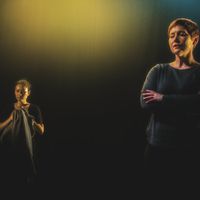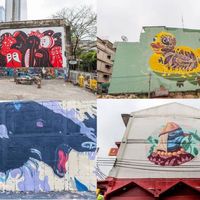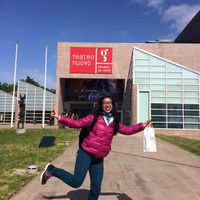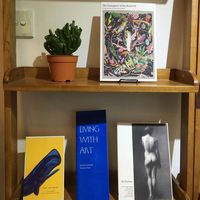In conversation at Transmediale

 Transmediale.10 took up residence at the House of World Cultures in snowy Berlin in the first week of February 2010. Transmediale is an internationally prestigious festival for contemporary art and digital culture and one of the main new media events in Europe. It draws artists, thinkers, curators, writers and curious-minded observers from around the world for a diverse programme of conferences, workshops, screenings, performances and exhibitions.
Transmediale.10 took up residence at the House of World Cultures in snowy Berlin in the first week of February 2010. Transmediale is an internationally prestigious festival for contemporary art and digital culture and one of the main new media events in Europe. It draws artists, thinkers, curators, writers and curious-minded observers from around the world for a diverse programme of conferences, workshops, screenings, performances and exhibitions.Transmediale.10 took the theme FUTURITY NOW! - reflecting on the boundaries of the “fading concept of the future”. Central to the programme was The Futurity Long Conversation, a 9-hour relay of one-to-one conversations, bringing together 21 leading artists, designers, theorists, journalists and media interventionists together to discuss, contextualise and explore a multiplicity of utopias, projects and technologies crucial for the ways in which we conceive the future today.
Didn’t make it to Berlin? Check out the tm video archive for these very interesting and often unexpected dialogues. Culture360 also strongly recommends the keynote speech of Bruce Sterling on ‘Atemporality’.
Culture360 Europe Editor Judith Staines conducted a series of one-to-one short conversations at Transmediale and asked selected participants what they sought and found there. We also wanted to hear their ideas about international collaboration between artists and cultural activists in Asia and Europe. In conversation with Culture360 were:
Denisa Kera (DK) – a curator and assistant professor from Prague, Czech Republic, working at the National University of Singapore on the Communications and New Media Programme, researching various technologies and interactive media design perspectives. Denisa was part of the Long Conversation event.
Gustaff Harriman Iskandar (GHI) – artist, writer and curator from Indonesia, co-founder of the Bandung Centre for New Media Arts and its Common Room, an open platform for art, culture and ICT/Media. Gustaff was also part of the Long Conversation event.
Clymene Christoforou (CC) – co-director of ISIS Arts in Newcastle upon Tyne, UK, a visual and media arts organisation which facilitates international and inter-cultural exchange through residencies and other projects. Clymene is on the Board of Culture Action Europe.
Salvatore Iaconesi (SI) – an Italian artist and activist based in Rome, working in collaboration with Oriana Persico on the FakePress project, subversive supermarket squatting and the Roma Europa FAKE Factory global competition.
Susa Pop (SP) - Managing Director of Public Art Lab Berlin and coordinator of the Media Facades Festival Europe 2010. Susa contributed to the Free Culture Incubator workshops on new creative business models at Transmediale.
Anita Babao & Vanessa Weiss (AB/VW) – two young German university students on a communications and media course, who were interviewing Transmediale participants as a project.
C360: What brings you to Transmediale?
DK: I came to participate in The Long Conversation. I’ve known Transmediale for years so it’s an opportunity to catch up with friends here. I also connect the conference with research I am doing in Europe into the convergence of personal genomics with the web and social networking sites.
GHI: In the past few years we have been involved in many interesting projects and initiatives in Common Room. As an open platform for art, culture & ICT/ Media, we have been working with numerous individuals and communities with different background and interests. Among many things that we did is to disseminate information and knowledge on free and open source software (FOSS) with the local community in Bandung. Since 2006 we have been working together hosting discussions, workshops, and gatherings to use FOSS for artistic and creative tools together with Klub Linux Bandung (KLUB). It is a slow progress though, but somehow this collaboration has encouraged some friends to explore the possibilities of using FOSS for their artistic works. Later on, this initiative led us to participate in the Global Conference on Open Source 2009. I did a small presentation about some of our activities. I think this is how Stephen Kovats [Artistic Director of Transmediale] picked up the thread and invited me to participate.
CC: The chance to see work, to meet people who make and facilitate the work, the chance to engage with agendas that go beyond our borders, the chance to find opportunities for collaboration, which usually happens at this kind of festival. Also the opportunity to meet people again you saw in another festival or conference – sometimes that is the basis for a future collaboration.
SI: We’re on a mission! Oriana Persico and I are writing a peculiar book and we are here collecting interviews. The book is about a shadow institution. The Romaeuropa Foundation ran a competition for new media art which, in our opinion, did not adequately respect the rights of the participating artists. So we cybersquatted their web domain and ran an alternative new media art competition – the RomaEuropaFakeFactory/REFF. It was very successful and 1000 artists applied. This year the Foundation created a new version of their competition, copying our alternative model, but again applying their more restrictive rights conditions for participants. So we got into a discussion with them and made some legal representations. As a result the Foundation offered to fund us to write a book about new media art.
SP: I have been invited to do a Walk-in Workshop ‘Reclaim the Screens!’ to present the Media Facades Festival Europe 2010 and as a part of the Free Culture Incubator - a workshop about ‘Creative Business Models’.
AB/VW: We are doing a project for our final exam, making short interviews with participants at Transmediale.
C360: What have you seen or heard here that has made an impression?
DK: The most interesting meeting I had was with Gustaff (Harriman Iskandar). I knew him online and through Facebook but we had to come to Berlin from Asia in order to meet. I heard all about the wonderful projects he is doing in Indonesia.
My favourite artwork in the exhibition is Carnivorous Domestic Entertainment Robots by Jimmy Loizeau, James Auger and Alex Zivanovic. I dialogued with Jimmy in the Long Conversation – I find it the most interesting project. It is also useful and provocative – I want one in Singapore to eat up the flies and mosquitoes!
GHI: I think Transmediale.10 has given me a brief impression of the European media art scene, which is totally different from Asia. As Stephen Kovats put it: “different places, different story”. And I think it is quite normal. The theme Futurity Now! is quite a challenge since I think that our notion of the future in the context of art and technology somehow always has a strong relation with some social, cultural, and perhaps historical and political aspects; from which the discourse and practice is emerging. My discussion with Gabriella Giannachi [in the Long Conversation] was quite interesting, as she mentioned that the future is a live archive - the past is our future. Although this is a speculative reflection for me, it suddenly encourages me to critically reflect on some shared narratives and strong historical ties between Europe and Asia, in particular between Amsterdam and Bandung, where I live and work for several years.
As I said in the email to Gabriela, sometime in the past some Dutchmen saw the perfect location for their future in Bandung, but that future has already become our past. Back in colonial times, there were many projects developed by the Dutch, where you can now find only ruins and decay. I am quite impressed to know that in 1923 the Dutch built a radio station with 2 km wide antenna in Bandung just to make a connection with Amsterdam. This is a somewhat bizarre thing to imagine in our present time, especially within our digital connectivity in the internet era. But of course, there is also a different story that we have to critically address, since I do think that there are some issues that still remain in terms of historical narratives between Asia and Europe or Indonesia and the Netherlands. I am curious to see whether current technological advantages could bring us to go beyond the logic of colonial and post-colonial narratives.
I have to tell you that The Long Conversation has left a strong impression on me since it allowed me to discuss and especially to listen to many interesting insights and reflections. My talk with Jaromil somehow also opened up a discussion that went beyond technological tools and advantages. I think he made it clear that a critical approach is required to address repressive control over privacy and intellectual property. Since we have been reaching the time of openness and connectivity over the internet age, somehow we have been losing our ability to share and connect with our own times. I feel this is an irony of our futurity.
In general, I really enjoyed all the talks and conversation, including some works that were presented at Transmediale.10. I really like the works by Alice Miceli (Chernobyl Project - The Invisible Stain). I feel this piece is a strong statement that brings immediate attention to the danger of apparently invisible nuclear energy. When I saw this work, I thought of the growing discussion to build a nuclear power plant in Indonesia, which I hope will not happen anytime now or in the future.
CC: In the exhibition I really enjoyed the work by Japanese artist Ryoji Ikeda – a large-scale audiovisual installation with a rolling sea of data. I liked the clubtransmediale sound art nights because it took me somewhere I don’t usually go [clubtransmediale/CTM – Berlin’s unique Festival for Adventurous Music and Related Visual Arts - is a parallel event to Transmediale]. Some of the Salons were interesting: e.g. the ‘Forms of Cultural Organisations’ where Trebor Scholz talked about the exploitation of the internet and who owned work; especially the discussions on clever processes for self-engagement. I also found the keynote speech by Richard Barbrook gave me the bigger picture to visions of the future, placed within the history of the use of technology, the cold war and issues of control and power. It was great to have the reminder of a world perspective.
SI: A series of things have happened here. We have had very deep exchanges with a few people. One of the exchanges which made a deep impression was with Marc Garrett who runs Furtherfield.
I didn’t go to the exhibition. I would rather hear from other people what they think of it and see the artworks through their eyes and descriptions. For me, the value of the art objects is in the people who build them. I prefer the relationships to the actual works.
SP: I liked very much the project of Valu€s by I-Wei Li in which you could measure your own cultural value.
AB/VW: The Media Personifications film was very creative and powerful. It was inspiring.
C360: What strategies can you recommend to artists in Europe and Asia who want to collaborate?
DK: One frustrating part is that I don’t see enough initiatives to bring together artists in Europe and Asia. In Asia we are lacking institutional and financial support. It is not there either at the art/cultural institution level or within universities. I wish it were as easy as it is in Europe! Also, in Asia, I miss these international networking events. Lots of interesting ideas are coming out of Asia – it is very active with BarCamps and geek culture where young people are organising new media events. It would be nice to tap into this culture and make a bigger event to create some synergies.
GHI: I think that collaborative practice always has to count on shared interests. I know that there is a huge difference between Asia and Europe, which reflects a gap between the south and north. But at the moment we are facing the notion that our historical ties could also become shared narratives that connect us together. Perhaps we can make our differences a point of departure for further dialogue and negotiation which, in the end, could bring us to some interesting collaboration. As the dark scenarios of global climate change become more imminent and somehow civil voices have drifted under repressive control, I do think it is time for us to reflect and critically address this matter with a different approach. Perhaps it is timely and correct for us to turn the tables round and bring out all the stories that we once always tried to hide. I think artists are good storytellers. At the moment we really need a good story to celebrate our humanity.
CC: It’s getting easier through the internet to make contact and engage in practice with people who are in other places. The nature of online work invites collaboration. I suspect that the younger generation does this more naturally. It’s part of who they are and younger people are a lot more confident about not needing face-to-face contact.
I think curatorial trips to festivals and other events are a good way of doing things elsewhere with people who have shared interests. For example, I have met here a group of media art MA students from Newcastle University.
SI: What is most important? Relationships – talk to people who do things you like. Establish contacts. Produce values. AND learn how to write business plans! You might not like them but they are useful.
AB/VW: Artists in Europe and Asia need a platform where they could meet and they need opportunities to work together. Something like an international festival, workshops, presentations - they need face-to-face contact in order to collaborate. But we have studied cultural difference at university and we learned that it is very complicated and people have very different ways of working and thinking.
Judith Staines is the Europe Editor of Culture360.org. She is a freelance writer, researcher and project manager based in the UK who specialises in European cultural cooperation and international mobility issues. She has worked on many projects for European cultural networks and was General Editor of www.on-the-move.org cultural mobility website 2004-2009. She is co-author of an EU-commissioned guide to mobility of cultural goods between Russia and the EU and has written handbooks for visual artists in the UK.




